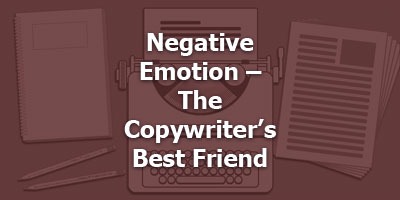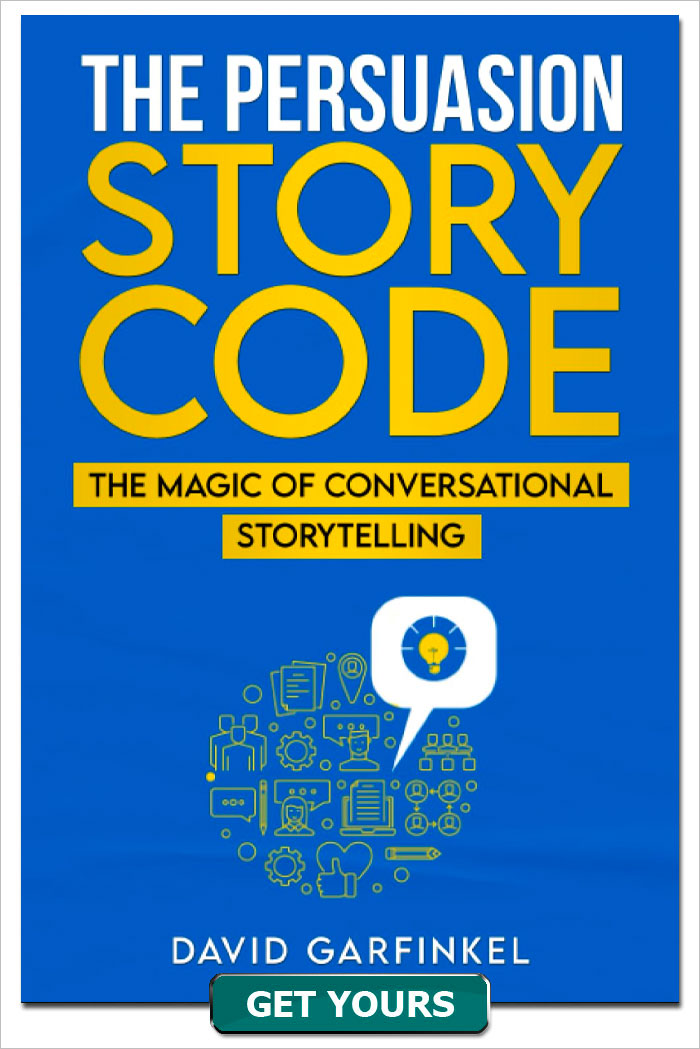Episode 029 - Negative Emotion - The Copywriter's Best Friend
Published by: David Garfinkel on 11-05-2017
Tweet
The other day I was watching a TV interview with a Hollywood actor in his 80s. The interviewer asked him, "What do you think of all the new movies with special effects and robot characters?"
The actor clearly didn't want to answer the question directly. Instead, he said: "What I look for in a script is three things:
1) What's the story?
2) Who are the characters that embody the story?
3) What's the emotion?"
It was a good answer, and I think the third thing the old actor mentioned is also important for copywriters. Even more than that, I think the conventional wisdom we've gotten about emotion is not nearly specific enough to be useful. I'll review the conventional wisdom in this episode, & replace it with specifics you can use.
Before we do, here's something that you might not find emotional at all:
Copy is powerful. You're responsible for how you use what you hear on this podcast. Most of the time, common sense is all you need. But if you make extreme claims… and/or if you're writing copy for offers in highly regulated industries like health, finance, and business opportunity… you may want to get a legal review after you write and before you start using your copy. My larger clients do this all the time.
Now, let's talk about emotion in copy.
You'll often hear that the emotions you want to appeal to in copy are fear and greed.
There's truth in that. But it's so broad and general. And what can you do with that information, really? It leaves you guessing. We'll get very specific in just a sec.
First, let's start with some basics:
- You need to provoke emotion to prompt a sale. People don't make decisions based on rational thinking, even though some think they do (and would get very upset if you told them otherwise. Hmmm… think about that!)
People make decisions based on emotion. So you need to prompt emotion.
- You can prompt positive emotions, but that's much harder work, since people don't always trust or believe good feelings. But they do tend to believe negative emotions more often. Negative emotions seem more "real."
- So today we're going to focus on three proven uses of negative emotion. These are from Chapter 9 of my book Breakthrough Copywriting. I call them "emotional triggers."
- What I'm going to share with you can be adapted in almost any selling situation to sell a product or service.
Emotional Trigger 1:
This one's called "Anger to Envy to Offer."
Let me read some copy to you, and then we'll dig into it.
This copy is for an ebook on auto repair:
"For most people, the only thing worse than going to the dentist is taking your car to the mechanic. At least the dentist warns you when he's going to hurt you and he does his best to numb the pain, but Mike Thompson is different.
"For Mike, going to the mechanic is never a big deal, because he's never been overcharged, and he always gets treated with a level of courtesy and respect that a king would expect. Does Mike know something you don't know? He probably does, and that's why I thought you'd be interested in his new eBook Never Let Your Mechanic Intimidate You Again: How to Stay in Control and Save a Lot of Money with Every Auto Repair You Get from Now On."
OK – what's going on here?
Let's talk in broad-brush strokes about the psychology of this:
Anger and jealousy are two of the most powerful motivators known. In fact, someone said to me that jealousy is fear of loss brought into the immediate present. Think about that. If you see someone else walking away with something you want, that's fear of loss right before your eyes.
Now, in this case, I made a statement that would arouse anger in my target market. If I had this book, and you have a car, and you've ever been treated badly by a mechanic, you'd probably buy the book right now, wouldn't you?
The second thing is that I made a contrasting statement about a positive aspect of the same situation. Here is the contrasting statement. "But Mike Thompson is different. For Mike, going to the mechanic is never a big deal because he's never been overcharged, and he always gets treated with a level of courtesy and respect that a king would expect."
Do you feel a little jealous of this guy? We've gone from anger, "That blankety-blank mechanic said it'd be ready at five and it's not done," to envy, "This other guy never has to put up with it," to offer, "And here's my offer." "Does Mike know something that you don't know? He probably does, and that's why I thought you'd be interested in this new eBook, Never Let Your Mechanic Intimidate You Again."
The way you can use this is
• Make a statement your prospect or reader can identify with – about a negative situation that gets them angry. Just not angry at you.
• Then, make a contrasting statement about a positive version of the same situation. Your prospect reading this will feel envy of the person in this situation who has it better than they do.
• From there, slip right into your offer – the solution that can get your prospect out of the bad situation they're currently in, and into the situation of the person they envy, from your story.
Emotional Trigger #2:
It's called Doubt to Confidence.
Now, notice only the first emotion is negative – doubt. I mean, who doesn't want to feel more confident in life?
Here's some copy for an imaginary ebook for doctors, dentists, chiropractors, and other health-care professionals. Listen:
"Professionals have an especially thorny problem when it comes to marketing, because often the kind of marketing likely to work is deemed too aggressive. On top of that, ethical standards often stand in the way of getting results from ads and mailings. When I started to read Never-Empty Waiting Room, I wondered if it would have the same tepid techniques I've read about so many times before."
That part was the doubt. Now, here comes the confidence:
"It turns out my fears were groundless. The go-for-it methods mentioned in this book could never be called unethical, yet they work like a charm… "
And you can almost feel the formerly worried prospect breathe a sigh of relief.
The way you do this is pretty straightforward – you use a testimonial that starts out with the same doubts a prospect has. And you give the story a happy ending by transforming the doubts into confidence.
When you ask someone for a testimonial, find out from them what specific results they are getting. Ask them to think back to when they read your copy. Was it hard for them to believe at the time that they could get these results? Ask them to include how they felt before, and how they feel now. And to tell why they feel that way.
This is another reason you should constantly be gathering testimonials.
Emotional Trigger #3:
This one's called "Shared Outrage." That sounds like a lot of fun, doesn't it?
Here's an example of this trigger in copy:
"You know what it's like when diets don't work. It sucks. I remember one so-called 'diet' I went on. What a load of crap! I had stomach pains for weeks! I didn't sleep well, I was crabby and tired all the time, and at the end of five weeks I'd gained five pounds! I was so mad I wanted to smash something into a thousand little pieces.
"It was then that I made myself a solemn promise—never go through that humiliation again! I wanted a way to lose weight that was easy and permanent. I searched and searched until I had all the pieces in place for the perfect program—the No-brainer, No-gainer Weight Management Plan. And now I'm ready to share it with you."
See, the way this one works is you AND the prospect get mad at the same thing!
And your solution solves the problem you're both mad about.
And here's how you do it:
First, you express your anger about a situation you're upset about, that your prospect is upset about, too.
That's anger, and people can relate to that anger. But you're not angry AT them – you're angry at the same thing they're angry at.
Then, you use that anger as a springboard to get to a solution. One that soothes your anger, and should soothe your prospect's anger as well.
--
OK, that's it – three emotional triggers:
1. Anger to Envy to Offer
2. Doubt to Confidence
3. Shared Outrage
That's three of 11 emotional triggers in total, in chapter 9 of Breakthrough Copywriting. And the book has 12 other chapters with hands-on, ready-to-use tools as well.
Keywords: fear based selling drama solutions emotions









